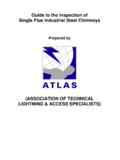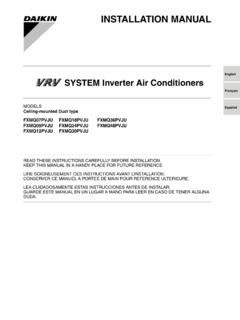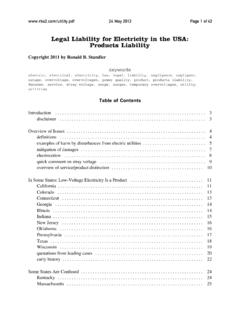Transcription of Conventional and Un-conventional Lightning Air …
1 FORUM ON Lightning PROTECTION, Hilton Petaling Jaya, 8th January 2004 1 Conventional and Un- Conventional Lightning Air Terminals: An Overview Hartono Zainal Abidin, BSc (Elect), MIEEE Robiah Ibrahim, BSc (Elect), MIEEE Synopsis The un- Conventional Lightning protection air terminals (AT) have been around since the invention of the Lightning rod by Benjamin Franklin in the 18th century. However they had never been proven theoretically and practically by their proponents. The current un- Conventional ATs, such as the Lightning eliminators, the radioactive Lightning rods and the early streamer devices, were introduced since the 1970s and they too had never been proven.
2 Although they do not comply with the then and existing Lightning protection standards, they were used on many projects in Malaysia and around the world. This paper reviews the development of the current un- Conventional ATs and their evaluation based on theory, laboratory and field studies. The paper also discusses the standards proposed for the un- Conventional ATs in the last decade. The paper also takes a look at the developments in Malaysia in terms of standards implementation and LPS studies conducted by a local university. Introduction Lightning is a natural hazard that is more prevalent in the tropical region than elsewhere.
3 In Malaysia, the average number of thunderstorm days1 per year is between 79 (Kudat) and 202 (Bayan Lepas) according to information provided by the Malaysian Meteorological Service. This figure is very high when we compare it against the temperate countries like Britain where there is only between 10 and 20 thunderstorm days per year. Consequently, the damages and casualties as a result of direct Lightning strikes are much higher in the tropics. Hence there is a vital need for protection against direct Lightning strikes. This protection comes in the form of a Lightning protection system (LPS).
4 The LPS used in this country and around the world are basically divided into two types: Conventional or standard LPS that which comply with the technical standards/codes of practice Unconventional or non-standard LPS those that do not comply with the standards/codes While the sale and use of the standard LPS is legal since it complies with the national and/or international standards and has been scientifically proven to provide safety to the users, the sale of the non-standard LPS did not. Lightning protection standards Like many electrical products in the market, a LPS is required to comply with the technical standards set by the IEC or by the respective national standards body (eg.)
5 SIRIM). When 1 Hartono, Z. A. and Robiah, I., Thunderstorm day and ground flash density in Malaysia , National Power Engineering Conference (PECon2003), Bangi, December 2003. FORUM ON Lightning PROTECTION, Hilton Petaling Jaya, 8th January 2004 2such a system complies with the recommendations set in the standard, it is known as a standard LPS. The Lightning protection standard is usually developed by a technical committee comprising of academics, experts and industry practitioners who are knowledgeable in the field and are responsible for ensuring that the LPS to are scientifically validated and proven.
6 Hence by complying with the standard, the consumer (eg. property owner) will be assured that the LPS installed will provide a meaningful and effective protection against the hazards of Lightning . The existing Lightning protection standards that are sometimes referred to in Malaysia are the IEC-61024 (International), BS6651 (United Kingdom), NFPA780 (USA), AS/NZS 1768 (Australia & New Zealand), and CP33 (Singapore). The first Malaysian Lightning protection standard was the MS939 which was developed in 1984. It has since been replaced by the IEC standard, the IEC 61024, in 2001 and is now known as the MS-IEC 61024.
7 Standard Lightning Protection System The main component of the standard LPS is the Conventional air terminal ( Franklin rod) that was invented by Benjamin Franklin around 1750. After more than 250 years in existence, the Franklin rod is still in use throughout the world and it has recently been scientifically validated in two major studies conducted by the AGU2, a reputable international scientific organisation, and the Federal Interagency Lightning Protection User Group3, a technical body representing the United States government. The Franklin rod is a passive device it serves as a sacrificial device when the Lightning strikes it rather than the building.
8 In a typical building, several of these Franklin rods are installed at various locations on the roof that are likely to be struck by Lightning . In this way, the Lightning will have a high probability of striking the Franklin rods instead of the roof. Therefore, the building is considered protected from direct Lightning strikes. The other components of the standard LPS are the down conductor and the earth terminal. The function of the down conductor is to channel the Lightning current safely from the Franklin rod to the earth terminal. The function of the earth terminal is to safely dissipate the large Lightning current into the ground effectively.
9 A locally manufactured Franklin rod costs around each or less while an imported version may cost up to twice as much. The Franklin rod is not protected by a patent. 2 Report of the Committee on Atmospheric and Space Electricity (CASE) of the American Geophysical Union on the Scientific Basis for Traditional Lightning Protection Systems ( ) 3 The Basis of Conventional Lightning Protection Technology, A review of the scientific development of Conventional Lightning protection technologies and standards , Report of the Federal Interagency Lightning Protection User Group, June 2001.
10 ( ) FORUM ON Lightning PROTECTION, Hilton Petaling Jaya, 8th January 2004 3 Non-standard Lightning Protection System In the 1970s, two types of unconventional air terminals had been commercially re-invented4 and introduced in the world market. They are the Lightning prevention air terminal and the Lightning attracting air terminal. Only one un- Conventional air terminal is usually installed centrally on the roof of a building such as a bungalow or a high-rise apartment block. However, for buildings with a larger roof area, two or more un- Conventional air terminals may be installed and they are normally spaced at some distance apart from one another.




